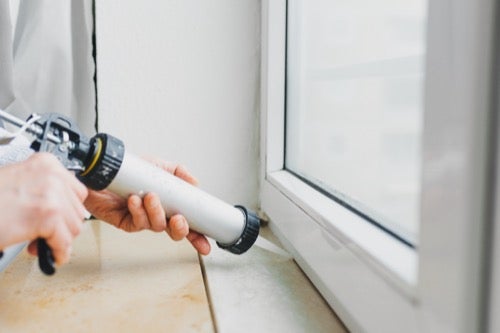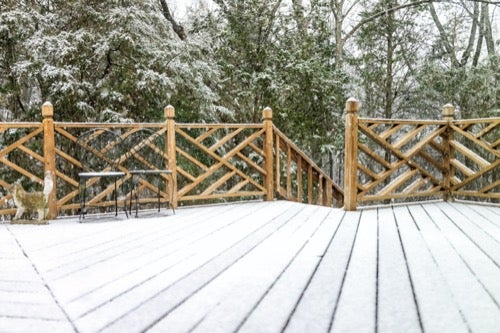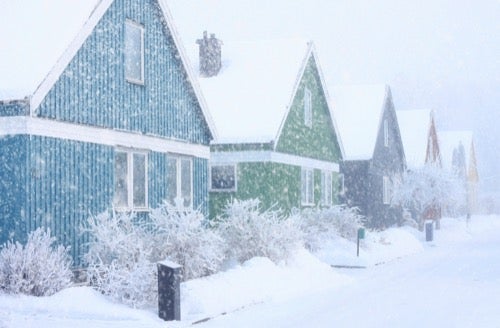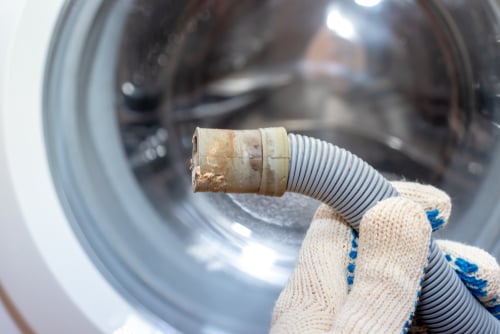Need a checklist to winterize the outside of your home? Follow these steps to have your home ready for winter.
Winter can take a severe toll on your home. Cold temperatures and winter weather can have negative effects on all parts of your home, so winterizing your home for winter is essential. However, you may be wondering, what does winterize mean? Winterizing is the process of protecting your property with a series of tricks that can keep the cold out and keep the outside of your home looking perfect when the snow melts. Frontdoor is sharing what you need to know to winterize your home so no matter how cold it gets, you’ll be prepared and cozy.
Take it all in
Literally and figuratively. First, the literal sense: if you have things outside that can be brought in the house for storage, like outdoor cushions and furniture, plants, or anything else that could be at risk of getting icy or worse—mildewy at the end of the season—you should try to bring them inside. To winterize outdoor plants, you should bring them inside. If that isn’t possible, adding plenty of fresh mulch after the first hard freeze can help protect your plants.
Now for the figurative sense: take a walk around the house and take it all in. Look closely at the roof to ensure that it doesn’t need repairs, examine walking surfaces that could become slippery with ice and may need treading, and inspect any areas on your home that could let the cold winter air in. Throughout the colder months, be diligent about removing snow and ice from your walkways and anywhere else you can to reduce the risk of snow and ice-related issues.
Banish autumn leaves
Leftover fall leaves can clog gutters and create icicles, ice dams, and other issues that can easily be avoided with a simple cleaning. Clean gutters can help protect and prevent your pipes from freezing during the winter months by allowing a steady flow of water through your gutters and away from your home.
Mind the gaps

Though this mostly affects your indoor heat, it’s worth including on the outdoor winterizing list. Any small gaps in your foundation, your windows, or your thresholds.
Move from the ground up, first looking for any cracks in your foundation. Expanding foam can fill fissures to keep your foundation insulated. Next, check your exterior doors. It might be necessary to place draft guards on the bottoms of doors to keep any air from getting in near the threshold. From there, check each window for gaps. Use rope caulk or weatherstrip tape to close the gaps and make sure your windows aren’t letting cold air in or warm air out.
Have a pest inspection
Depending on where you live, you may also choose regular pest control to winterize your home. This will prevent small bugs, looking for a place to warm up, from crawling through any unseen gaps in the foundation, windows, or doors.
Plug the chimney
If you have a chimney, there are several things you can do to ensure it is ready for winter weather. First, inspect your chimney just like you inspected the rest of the house. Look for any cracks and fill them with expanding foam. Because chimneys are essentially open and hot air rises, it’s easy to lose a lot of your home’s warmth through the chimney. If you aren’t using that fireplace, you can plug it up with a chimney balloon, made to keep drafty, cold air out.
Prevent damage to your deck

When winterizing your home it’s important to remember to winterize your deck, especially if it is wooden. Start this process by cleaning your deck thoroughly with a pressure washer and sealing the wood with a water-resistant finish to protect it against the elements. One of the best ways to prevent winter damage to your deck is by covering it. If you can build a deck covering, you’ll be providing a year-round asset to your home that will provide shade in warmer months and prevent snow and ice buildup in winter months. If you do not have a deck cover, it is important to remove snow and ice from the surface to prevent a weight burden on the structure of your deck. Choose an ice-melting compound that is made for the specific material of your deck in order to keep from damaging it.
Protect the pool
No matter where you live, winterizing your pool is the key to keeping it in good shape for the next season. You’ll need to first balance the water chemistry to prevent algae from growing. The water pH, chlorine or non-chlorine shock, and algaecide can all be used to prepare your pool water for the winter. Clean your filters thoroughly before covering your pool (if you plan to) and once during the winter months to keep from finding a growing green swamp when you uncover your pool. You’ll want your pool as clean as you can get it before covering it, so you may want to run the filter for 24 hours in addition to vacuuming the pool waste and skimming the top. A pool cover is right for most homeowners to protect the pool from snowfall, debris, and other winter hazards. If you live in very cold places, you may need to lower the water level and blow out the plumbing of your pool. It may seem like a lot of maintenance to winterize your pool, but in the long run, it will save you money and keep your pool ready for summer.
A comprehensive winter home checklist can help you prepare for the colder months, but sometimes you need a little extra help to keep your home in top shape. Frontdoor’s Handyperson services are here to assist with essential tasks to winterize and maintain your home. From sealing drafts to tackling small repairs, our experts ensure your home stays safe and cozy all season. Prepare now with Frontdoor, and enjoy peace of mind knowing we’re here to help with winter upkeep. Learn more about how our Handyperson services can simplify your seasonal home care.
Was this article helpful?






